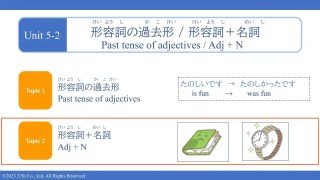Welcome to Lesson 5!
Ready to add more color and detail to your Japanese? In Lesson 5 at gokigen japanese blog, you will learn how to use adjectives to describe the appearance and characteristics of things and people around you. This is a key step to making your Japanese sound more natural and expressive.
The main goal of this lesson is to enable you to understand and express the appearance and characteristics of things and people using Japanese adjectives.
Key grammar and vocabulary you will master include:
- Introducing Japanese Adjectives: Learn about the two main categories of Japanese adjectives: い-adjectives (like たかい – expensive/tall) and な-adjectives (like きれい – beautiful/clean).
- Using Adjectives in Sentences: Understand how to use both い-adjectives and な-adjectives correctly at the end of sentences to describe nouns (e.g., このかばんはたかいです – This bag is expensive. あの花はきれいです – That flower is beautiful).
- Past Tense of Adjectives: Learn how to change both い-adjectives and な-adjectives into their past tense forms to describe past states or conditions.
- Adjectives Modifying Nouns: Discover how to place adjectives directly before nouns to modify them (e.g., おいしい食べ物 – delicious food, ゆうめいなレストラン – famous restaurant).
- Expressing Likes/Dislikes and Abilities: Learn how to use common adjective-like expressions such as 好き (suki – like/favorite), 嫌い (kirai – dislike/hate), 上手 (jouzu – good at), and 下手 (heta – bad at) to talk about your preferences and skills.
By the end of Lesson 5, you’ll be able to describe how something looks or feels, talk about what you like or dislike, and express whether someone is good or bad at something. These skills are essential for lively everyday Japanese conversation!
Explore the articles linked below to dive into Japanese adjectives and start describing the world in more detail!






